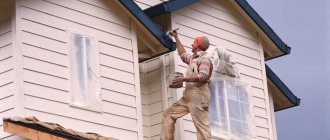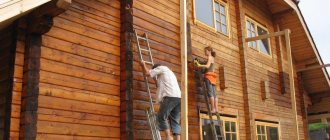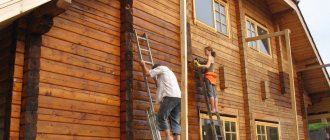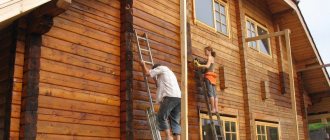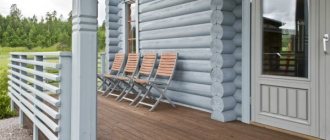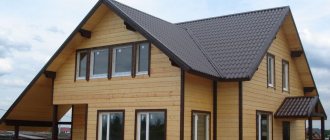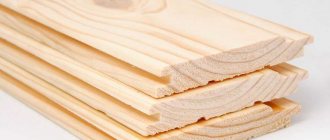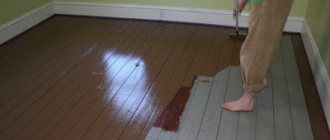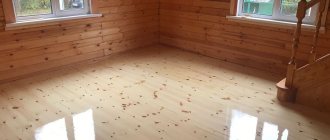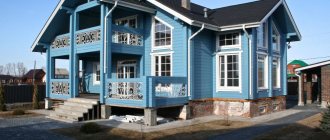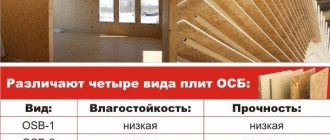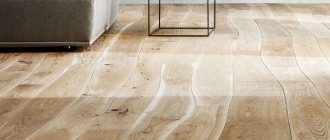The wooden facade of the house is extremely decorative. However, due to the specifics of the material, it requires more frequent care and maintenance than surfaces finished, for example, with plaster or glass. Use the recommendations on what and how to paint the outside of a wooden house so that it retains its strength and attractiveness for many years.
Photos of painted wooden houses from the outside
A wooden facade is one of the oldest methods of finishing the exterior of a house. The popularity of this solution continues unabated; a fashionable solution today is to make part of the façade from this material. Despite all the advantages of the method, natural material requires constant and careful maintenance. Impregnation and painting of boards with special products is necessary to protect them and improve their appearance. Consider effective solutions that will produce the desired results.
A few operating rules
If you decide to work with the presented color yourself, then the following tips will help you:
- A monochromatic design will look quite boring. It is worth noting that if you choose a dark tone, then the building will also be gloomy. The dark coating of walls and other facade elements visually narrows and makes a private or country house smaller. This will negatively affect the exterior;
- You need to choose the right style. This is the main condition before starting work. Today there are several directions that are suitable for using brown. We will talk about them further;
- Consider the geometry of the house. For example, if the building has an unusual exterior, bulky and pretentious elements, then it is better to refuse to use the presented option.
The best way to paint a wooden house outside: nuances of choosing a product
There are many products on the market for painting and protecting outdoor wood surfaces. Many of them, however, have properties that do not provide comprehensive protection for the facades of wooden buildings and at the same time do not provide the expected aesthetic appearance. For example, standard varnish used outdoors will not always provide the best UV resistance. Oils protect wood from the effects of atmospheric factors, but they are quickly washed out of the structure by rain, so the lubrication procedure must be repeated once every year or two. In addition, oil painted surfaces should not be exposed to direct sunlight.
Protection and decoration
Facade wood in the open air is constantly exposed to harmful sunlight, moisture, fungi, mold and pests, leading to the expansion of cracks, peeling of the coating, deformation and delamination of elements, which provoke serious damage to the wood. In addition, difficult conditions, such as winter frosts, acid rain and exhaust gases, cause wood to deteriorate much faster, losing its technical and aesthetic properties. Proper protection of wood with special means is required if you want to maintain its attractiveness and good physical shape for a long time.
Commentary by TM Belinka technologist
We asked the chief technologist-consultant of TM Belinka, Valery Ermakov, to shed light on the technical side of the issue.
So is it worth painting the facade dark?
“A clarification should be made to the words of other experts: facades painted in dark colors better protect the wood itself (or other material from which the house is built) from destruction, but at the same time they actually burn out more.
We paint the façade to protect it from the harmful effects of UV radiation. To do this, it is necessary to paint the surface with coatings with high light resistance, and inorganic iron oxide pigments have the highest light resistance. But the pigments, in turn, must be well “placed” in the binder and have very small sizes (several microns). All pigments, both light and dark, have high light fastness. Only on dark surfaces is the process of color change over time more noticeable than on light ones. It is believed (according to the laws of physics) that dark colors protect better from UV radiation.
2. Not all white paints turn yellow over time.
If you take into account high-quality white paints and glazes from reliable manufacturers, you should understand the following. The effect of some yellowing applies only to alkyd coatings, but acrylic coatings do not turn yellow in principle. But even alkyd coatings lose their whiteness only after a few years - due to the thinning of the film and the appearance of the base of the wood. That is, the natural color of the wood simply begins to shine through more.
Color fastness can be improved
To increase color fastness, it is necessary to regularly monitor the thickness of the color film after 4-5 years, which is the main barrier to UV radiation - the main enemy of color.”
Source: www.diy.ru
What color to paint the outside of a wooden house: photos of fashionable solutions
Depending on what product you use to paint a wooden facade, it is possible to completely change the color or emphasize the natural colors of the wood.
The attractiveness of light-colored facades
Light decor is a priority. The universal white color can be combined with any others. A very beautiful facade when combined with 2-3 natural shades.
Crystal clear should be excluded, as it is very easily soiled. It is better to choose a grayish tone that appears white among the dark shades of the cold range. If warm temperatures predominate, milk or cream will do.
Overly saturated and dark tones are more difficult to perceive and quickly tire the eye. Subsequently, it is possible to update with another shade of the same palette, while a dark base is very difficult to paint over. Light gray cannot be dyed brown or blue without resorting to several layers.
Source
What paint and varnish to paint the outside of a wooden house?
Facade elements and entire wooden surfaces should be treated with protective and decorative paint with properties that ensure a beautiful appearance and durability of the coating for many years. The protective layer of a suitable preparation must be flexible, stop the penetration of UV rays, prevent excessive peeling of the coating under exposure to the sun, and also prevent deep penetration of water into the wood. It is important that the product also provides resistance against the development of fungi, algae and mold. Walls on the north side are especially susceptible to their harmful effects. Consider two different preparations as a protective and decorative coating for a wooden facade. The first is BONDEX Extreme Decking 3 in 1 Topical Oil and the second is Acrylic Enamel Bondex.
Lakobeyts 3 in 1 Bondex Extreme Wood Care
Lakobeits is a multifunctional varnish. With its help, you can protect wood from various atmospheric factors, and the finish of the painted surface lasts up to 8 years. The product penetrates deep into the wood, protecting it from mold and mildew, as well as from decomposition caused by light, water and frost, thus providing maximum protection. Lakobeyts 3 in 1 Bondex gives lasting color, decorating natural wood, emphasizing its natural pattern.
Water-based acrylic enamel Bondex Acrylic Enamel 12 years
Using acrylic enamel Bondex Acrylic Enamel for 12 years, you can protect the surface from exposure to atmospheric factors and mechanical damage, but, above all, completely change the color of the facade. The product provides an excellent effect after applying the first layer. In addition, the product is durable and flexible, so it will not peel or crack.
Types of facing bricks
Ceramic
The raw material for its production is clay of different types. Some components are added to the clay to improve its quality.
It is worth noting that even when using clay from the same quarry, the color of bricks from different batches can vary significantly.
Clinker
The raw materials are refractory types of clay. To give a certain color, various pigments are added to the mixture. Firing is carried out at a temperature of about 1300 degrees, which gives the bricks greater strength.
Hyper-pressed
It consists mainly of waste from other industries (limestone, shell rock, waste of natural stones, slag).
To bind the components, cement and various pigments are added to give certain colors. Manufacturing takes place using very high pressure.
Silicate
It is made from quartz sand, lime, pigments and mineral additives. But it is practically not used for cladding the facades of buildings.
Before starting work, we recommend reading specialized websites about building facades. There you can find a huge number of photos of brick facades that will help you decide on the final version of your facade.
How to properly paint the outside of a wooden house?
Before you start painting the facade, the surface must be properly prepared. The scope of work depends on the condition of the boards. A preliminary inspection should answer whether it is enough to just sand the surface or whether any damage or defects should be corrected. Regardless of the condition of the facade, you should start by cleaning the boards with a brush and water and detergent. To remove dirt, use a spatula or machine. Only after this the facade should be treated with sandpaper or a grinding machine. It is then recommended to fill small depressions and remove loose wood particles. Damaged elements must be replaced with new ones. Before painting, surfaces must be dusted and dried.
Painting
After mixing, the product should be applied directly from the can using a brush or roller. For painting, you can also use a special spray gun if the application with such a tool is recommended by the manufacturer. Carefully go over the entire surface, including the boards and walls of the house, once along the grain of the wood. It is recommended to apply 2-3 layers of the product, observing the intervals intended for drying. A facade in good technical condition, which has been recently updated, only needs to be covered with 1-2 layers of decorative layer after sanding the surface. It is worth adding that wood paint must have the appropriate moisture content. In addition, painting work must be carried out in appropriate conditions, i.e. when the air temperature is not lower than 5°C and with a humidity that does not exceed 80%.
This way, the renewed and protected wooden façade will serve for many years. When you notice abrasion, fading, cracking or peeling of the coating, the outer walls of the wooden house should be repainted.
Color selection algorithm
So how to choose the color of the facade? “At the initial stage of choosing the exterior of a house, it is very convenient to use special programs or online services that allow you to choose the color of the walls, windows, doors, roof, base of the house and decide whether you like the color combination or not. At the next stage, we recommend visiting a house exhibition [open-air exhibitions where samples of finished houses are collected, popular in large cities - approx. author], where you can see the selected color and texture of the material live on samples exhibited by manufacturers.
To make a final decision, it is advisable to paint a piece of wall approximately 0.5 x 1 meter in size and observe the sample during the day under different lighting conditions, and also, preferably, under different weather conditions - sunny and cloudy. In this case, the selection error will be minimized as much as possible.
As for practicality, light colors fade the least. White fades the slowest. However, it should be remembered that white color may become yellow over time. Thus, the most practical in this case may be a gray, dim color. It does not turn yellow over time and dust is practically invisible on it.
Dark colors look very impressive on facades, especially those with simple architectural forms. However, remember that they fade quickly. The leader in fading is black. If there is a need to use dark colors on the facade of the house, then you should pay attention to the warranty card for the paint, which indicates restrictions on the period of fading. Usually this is 5-7 years for dark colors,” said Roman Konyakhin, manager of the “Low-Rise Country” exhibition of houses.
How to paint a plastered facade
When choosing paints for brick and concrete plastered facades, the same principles for choosing colors apply. But besides this, we should remember that our walls need paint not only for beauty. Yes, of course, the facade, and the whole street, where the walls of the houses are painted in bright colors, are pleasing to the eye, but it’s not just about the color. Paint must protect the surface of the facade from destruction: the sun, frost, strong winds and unclean air can damage even the most durable materials.
